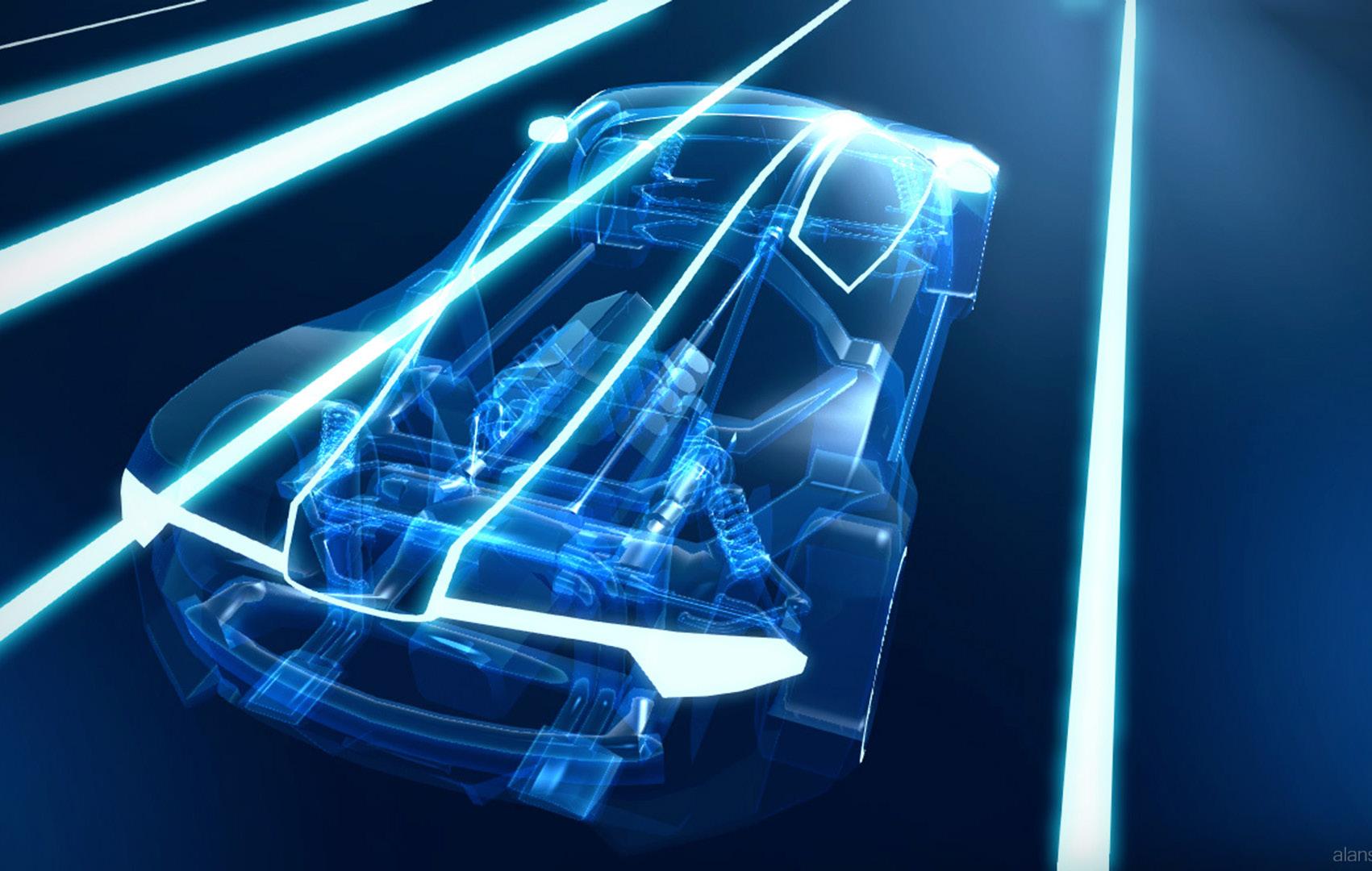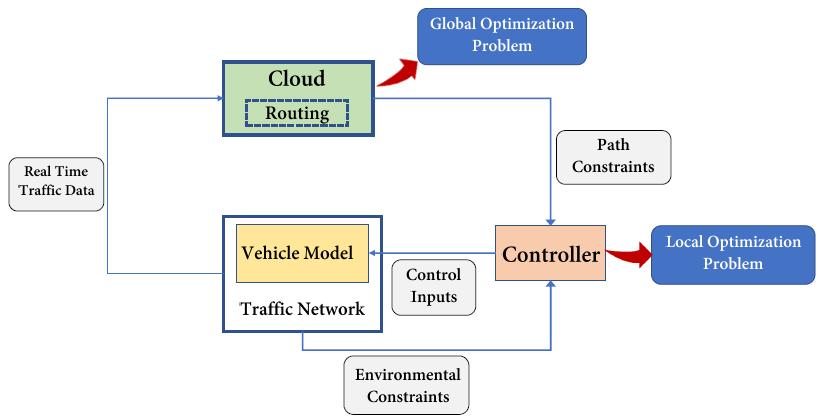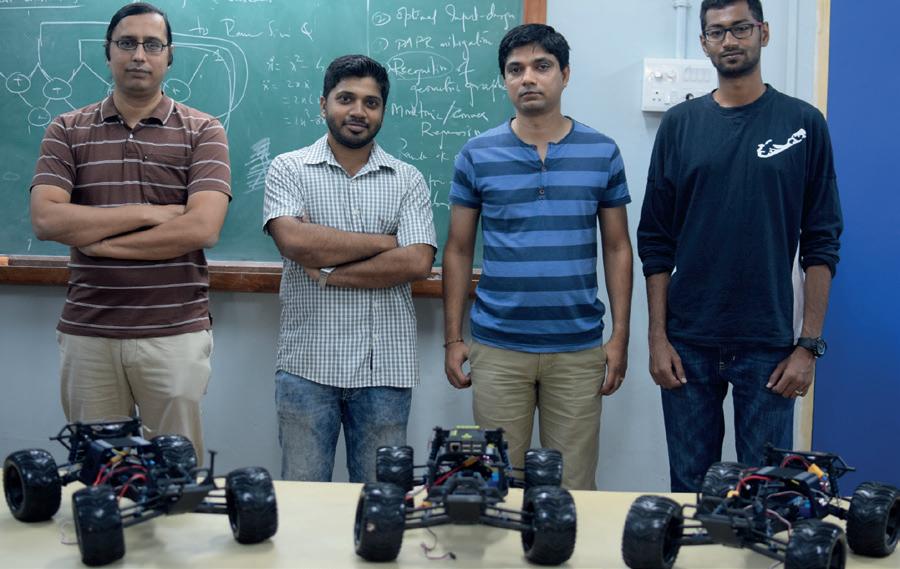
10 minute read
Self Driving Cars: Darkest Secrets Revealed
from Immerse 2018

by Praneeth Srivanth
Advertisement
Have you ever wished your car to operate on its own after a tiring drive on a highway? Can you imagine a scenario where traffic jams are virtually non-existent? Would it be truly possible to avoid the endless queue outside a parking lot?
Here’s a sneak peek into the amazing amount of work done in the field of semi-autonomous vehicles by the trio - Dr. Nirav Bhatt, Dr. Ramkrishna Pasumarthy and Mr. Subhadeep Kumar at IIT Madras.
Chemical Engineering
Advancements in the domain of intelligent vehicles and semi-autonomous cars might soon put an end to the frustrations faced by drivers in conventional vehicles. Let’s start with looking at how a person driving a vehicle goes about the whole process in a system without automation. The driver observes cars whizzing past, monitors them through a rear view mirror to get a picture of the traffic condition behind, uses external inputs to apply the brakes at the most appropriate time and accelerates the vehicle if the coast is clear. The primary objective of the whole process is to skillfully navigate the vehicle through the traffic. We might imagine this to be a rather complex task if we were to account for these details and model them. This is at the very core of the challenge that the trio aims to tackle.
As the brains behind such vehicles were designed only by human brains, it comes as no surprise that the semi-autonomous vehicles pretty much mimic what the human driver does. The motion sensors, GPS, LIDAR (Light Detection and Ranging) are the eyes of semi-autonomous vehicles. The control system, image processing algorithms, automatic detection of ambient vehicles constitute the brain of the semi-autonomous vehicles which enable the decision making process in order to charter out proper action plans.
One can see that the coordinated effort that is required in operating a vehicle is as demanding as is required in a multi-instrumental orchestra. The engine has to run properly, the correct amount of brake force has to be applied, the brake force has to propagate and reduce the speed of the vehicle and the wheels have to turn accordingly. In essence there should be no internal discord. If the functioning of all the individual components is accurate, but the system as a whole has a lacuna, then it is akin to the clichéd statement ‘’Operation Successful but Patient Died’’. Ultimately, just like how a butterfly with thousand eyes would just collapse if its nervous system did not direct it to move in the right direction, the control system has to take up all the responsibility in guiding the vehicle based on the gamut of sensors that populate the vehicle.
Self Driving Vehicles – Levels of Autonomy
Level Zero: No automation You drive it – acceleration, braking and steering are all controlled by a human driver Level One: Driver assistance Hands on the wheel ‒ in certain cases, the car can either take control of the steering wheel or the pedals Hands off the wheel, eyes on the road ‒ In certain modes the car can take Level Two: Partial automation over both the pedals and the wheel, but the driver must maintain ultimate control over the vehicle Level Three: Conditional Automation Hands off the wheel, eyes off the road (sometimes) ‒ In certain modes, the car can take over the driving responsibilities completely
Designing the Control System
There are two approaches that are commonly used by automobile companies in order to design the control system. One approach proceeds as follows: 1. Several trials are performed in the vehicle training phase wherein vehicles are exposed to a wide range of test scenarios such as traffic patterns, congestion levels, road conditions, etc. Various traffic scenarios, vehicular congestion, traffic signals, wet roads, road blocks, etc. are simulated and the vehicle is trained to perform a certain course of action.
2. After feeding in this data, the vehicle is expected to be ‘intelligent’ enough to take its own decision in a real-world scenario.
The other end of the spectrum in design is to mathematically model all the possible subsystems of the automobile and then decide on a course of action which would take into account the precise details of the braking, steering and acceleration from a mechanistic point of view.
Both approaches pose various challenges that create complexities during analysis. Industrially, a blend of the two approaches is used with a dominant chunk of the design being based on the data-driven approach. While that might be sufficient from an operational point of view, an inevitable limitation of such a system arises from the over-reliance on the initial test scenarios that were used to design it. Even if a broad range of scenarios are used in the training phase, an extremely new scenario in the real world can throw the control system into confusion. This can lead to fatal decisions being taken. For instance, the appearance of vehicles or objects in front of the vehicle, or even the emergence of a sudden wall can cause the system to go crazy and misinterpret the prevailing ambient conditions.
Deconstructing the Semi-Autonomous Vehicles
To tackle these issues, it is absolutely important to have an underlying mathematical model that conforms to a strong theoretical basis while designing such systems. For such a model to have a precise amount of operational validity and practical performance, three important aspects have to be considered. 1. The number of components the system has to be broken into, should be optimal. 2. The model should be able to respond to difficult scenarios such as traffic congestions, steep turns, sharp curves, sudden brakes, etc. 3. The model has to be flexible enough to be extended to a plethora of automobile systems.
An important question for an engineer is to identify how many subsystems the automobile should be broken into, as a part of the modelling exercise. The number of components going into a car are numerous and one faces the challenge of being unable to clearly account for the number of components which have to be modelled. For instance, if one starts counting the number of nuts, bolts and goes into all the nitty-gritty details, it would be too much of an overkill. If one just models the system considering the big discrete entities, that might be an overapproximation as there would hardly be any subtlety in the details.
After several sessions, Dr. Bhatt and his team were able to divide the vehicle into its constituent parts namely the drivetrain, steering, suspension, torque converter, vacuum booster, brake, tyres and vehicle dynamics. The inputs which the control system can direct are the torque distribution ratio at the transmission, steering angle, torque converter clutch force and suspension height. The external disturbance though a multitude in number, are limited to rolling resistance, aerodynamic drag and gravitational pull. These are the entities which define the states of the model. The basic objective of the model is to enable safe and smooth navigation and to minimize travel time.
Validating the Model
The team has conducted several simulations to verify the reliability of the aggregated model by assuming a certain set of initial pressure conditions, flatness of the road, etc. so as to observe the trends in velocity and acceleration for a simulated ambient traffic condition. All the complicated mathematical models and convoluted differential equations come to life when the model is able to predict the vehicle behaviour for a number of test cases. In the presence of preceding vehicles, congestion, slow-moving traffic the model is able to continuously switch between braking and accelerating by skillfully altering the engine speed, throttle angle, braking force, etc.
Another oft-occurring scenario in real traffic, that of the ‘Stop and Go’ condition in which the vehicles stop at traffic signals without turning off the engines is also mimicked by this model which reduces the throttle input and brings the vehicle to a brief period of idleness. Thus a close resemblance of vehicle characteristics to real world behaviour is observed and hence this validates the accuracy of the model that has been developed.
The cornerstone of this model lies in the way the braking system of the vehicle has been represented. The applied braking force has to be measured with the highest possible accuracy for collision avoidance. The precision in the braking force is also an important aspect which can play a vital role in navigating through congested roads
Chemical Engineering
and dangerous curves. The braking model accomplishes this by considering the mass of air in the vacuum chamber, the force applied to the vacuum booster and the master cylinder volume displacement as the important states of the system. The braking mechanism that is manifested as a result of such a theoretical modelling can achieve smooth braking rather than causing a sudden braking in the device.
Pushing the frontiers of Semi-Autonomous Vehicles
As is with any mathematical model, the applicability of it is usually confined to the system for which it has been developed. The research group has developed a model which establishes an integrated interaction amongst all the components while retaining the individuality of the components. The model is unified yet distinct, integrated yet discrete, abstract yet simple, futuristic yet relevant. The mathematical framework which has been developed can be applied to any system with a simple modification, through which the frontiers of the model can be extended to any engine, any braking mechanism and any throttle system. On a futuristic note, the model could be used to replace a particular component with something that is not existent currently and can thus predict some really innovative and intelligent subsystems within an automobile.
The larger picture in this scheme of design lies with the integration of the vehicle model with that of a large scale traffic network model. Analysis of the predictions and decisions taken by semi-autonomous vehicles operating in a given location would be instrumental in designing a traffic network that has the least possible congestion levels at all times. Efficient techniques of route planning and route allocation for the various vehicles after accounting for the geographic and environmental constraints would result in a win-win situation for all the vehicles of that location. Thus an extension from a local optimization problem for a vehicle to a global optimization problem for the traffic system as a whole can be accomplished.
The enthusiastic researcher Mr. Subhadeep’s eyes gleam with perseverance and passion, and is extremely eager to explore newer frontiers of the model that has been developed. As an immediate step, strategies have been devised to accomplish the testing of the mathematical framework with a miniature table-top automobile prototype so as to add a further dimension of experimental verification to his extensive endeavours. Dr. Nirav Bhatt envisions a future, ten-years down the line when this model is industrially implemented so as to foster an era of cutting edge semiautonomous vehicles that can make foolproof decisions in almost any real-world scenario.
Figure : Control Architecture

Praneeth Srivanth (Author) Praneeth is a fourth year undergrad in chemical engineering with a keen interest in anything and everything pertaining to Science and Tech. Notoriously known for being a maggu max and research enthusiast, you can occasionally hear him hum classical music tunes and play the keyboard. He loves to spend his free time being engrossed in reading musicological journals, philosophical narratives and watching vintage films.
Dr. Ramkrishna Pasumarthy is an Associate Professor at the Department of Electrical Engineering, IIT Madras. He has obtained his PhD in systems and control from University of Twente, The Netherlands and has held post doc positions at University of Melbourne and UCLA. His research interests lie in the area of modeling and control of complex physical systems, identification and control of (cloud) computing systems and data analytics for power, traffic and cloud networks. He is also associated with the Robert Bosch Center for Data Sciences and Artificial Intelligence at IIT Madras.
Dr. Nirav Bhatt is a DST-INSPIRE Faculty Fellow at the Indian Institute of Technology Madras in the Systems and Control Group, Department of Chemical Engineering. He has obtained his M.Tech from IIT Madras and DSc from École Polytechnique Fédérale de Lausanne (EPFL), Switzerland. His research interests span Analysis of Reaction and Smart Infrastructure Networks using Systems Theoretical and Machine Learning Methods. He is also associated with the Robert Bosch Center for Data Sciences and Artificial Intelligence and Initiative for Biological Systems Engineering at IIT-M.

Dr. Nirav Bhatt and Dr. Ramkrishna Pasumarthy with their research team










